A tiny croissant-shaped island lay just off France’s Atlantic Coast. It’s not far from La Rochelle, but only accessible by boat. That little island, called Île d’Aix, is practically a French secret.
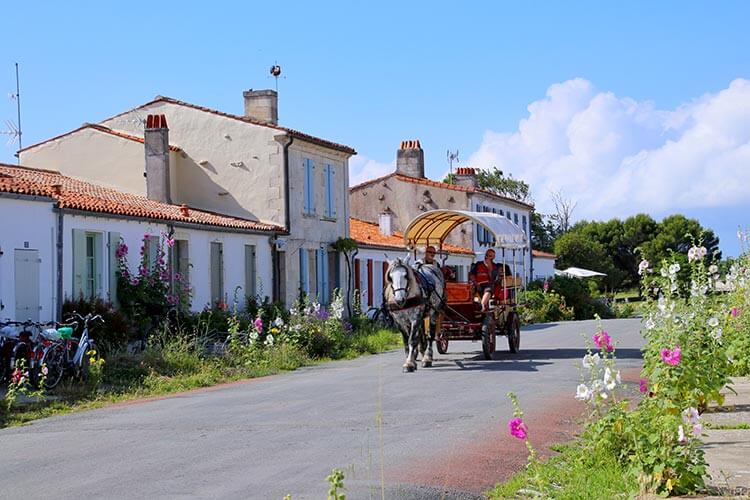
Popular as a day-trip destination in the Charente-Maritime among almost exclusively the French, Île d’Aix is the epitome of French charm. There’s just one hotel, the Hotel Napoleon, nestled in the village among Île d’Aix’s 234 residents. Almost entirely car-free (with the exception of a few service vehicles), Île d’Aix is discovered on foot, by bicycle or in a horse carriage.
It’s quite literally a little island paradise, earning the island it’s moniker of Pearl of the Charente Estuary. And Île d’Aix’s claim to fame is that it is where Napoleon spent his final three days on French soil before being exiled to Saint Helena in the summer of 1815.
At just 3 kilometers in length and 600 meters wide at its widest, the attraction on Île d’Aix is the island itself. It takes just a few hours time to walk or bike the island in its entirety. But it’s an unmissable destination with the colorful village and its fragrant hollyhocks, the five pristine beaches, the two museums and a fort, and the island gastronomy featuring fresh-caught fish and shellfish.
The Eventful History of Île d’Aix
A visit to Île d’Aix truly isn’t complete without learning at little of the island’s history. It’s been a fixture of the landscape since Roman times, though the island we see today didn’t really form its shape until around 1500. But in Roman times, it’s mentioned that you could actually walk out to the island during low tide – much like you can still walk out to nearby Île Madame along a 1-kilometer long causeway that is exposed during low tide today.
Île d’Aix was chronicled in the 11th century as being the place of a priory founded by the acclaimed Abbey of Cluny, after the island was given to the order of Cluny. The priory was dependent on Saint Martin on nearby Île de Ré.
But it’s the military history that left its mark on Île d’Aix. The French and the English battled for the island during the Hundred Years War, and it actually became English for about 15 years.
Because of the ongoing threat from the English to France’s Atlantic Coast, Île d’Aix was fortified and the village we see today laid out by the famous engineer Vauban, who also fortified places like the Citadelle of Blaye. With Rochefort becoming the seat of the French Navy in 1665, Île d’Aix became one of the strategic fortifications in the Charente Estuary to protect Rochefort from attack. Despite the extensive fortifications completed in 1704, the English still managed to take over Île d’Aix for several days in 1757 and destroy the ramparts.
The island was even more extensively fortified after the English retreated. The famous French captain Pierre Choderlos de Laclos was sent to help rebuild the fortifications. He even more famously finished writing Dangerous Liaisons while staying on Île d’Aix.
In a particularly unsavory moment in Île d’Aix’s history, the island became a prison during the French Revolution. In 1794 religious opponents were moored out to the island. Hundreds of priests and monks were left to die in the moored boats.
Once Napoleon became emperor, he took a keen interest in the fortifications of Île d’Aix. In 1808 he ordered reinforcement of the ramparts, a commander’s house to be built (which is now today the Musée Napoléon) and Fort Liédot to be constructed. Napoleon would never live to see Fort Liédot completed though. The English once again occupied the port of Île d’Aix in 1809.
And after being defeated at Waterloo, Napoleon fled and spent his final three days on French soil on Île d’Aix from July 12 – 15, 1815. He stayed in the commander’s house he had ordered built in 1808. On the morning of July 15, Napoleon boarded the Bellerophon never imagining that he would become a prisoner of war and be exiled to Saint Helena.
After Napoleon’s exile, Île d’Aix’s history was much less tumultuous. Fort Liédot served as a prison during periods of time until as recently as 1961, detaining Russian prisoners during the Crimean War of 1854 and Prussians during the Franco-Prussian War of 1870. Ahmed Ben Bella, future first President of Algeria, and his companions were also imprisoned there.
Though first and foremost a military stronghold, modern times have seen Île d’Aix become the peaceful escape it is today. It’s largely thanks to the Gourgaud family that Île d’Aix was saved from destruction after it was left derelict and abandoned in the 1920s.
A Day Trip to Île d’Aix
Île d’Aix is most often visited as a day trip, and a day trip will indeed give you the perfect escape to an island were time seemingly stands still. Only reached by boat, it’s just a quick 20-minute ferry ride from the Pointe de la Fumée at the end of the Fouras peninsula. The first ferry boats depart for Île d’Aix at 8:15am year round and almost all departures back to Fouras leave at 18:15pm. To soak up everything Île d’Aix has to offer, plan on the full day there heading over on the first ferry and departing on the last.
The French are in the know, and especially during the high season summer months from July to August, everyone packs on to the first and last ferries. While the crowd quickly dissipates once you reach Île d’Aix, you’ll notice the majority head straight toward the village. We headed in the opposite direction, leaving the village for the end of our day.
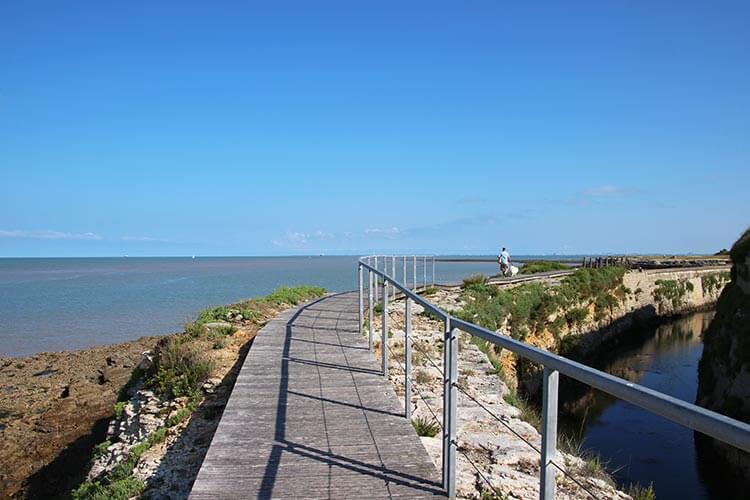
There’s a coastal trail to the left when walking off the pier and the unmissable twin lighthouses of Île d’Aix practically beckon you in their direction.
Listed as historical monuments since 2011, the twin 25 meter lighthouses are still in operation today. Though you can’t actually visit and climb to the top of the Phare de Île d’Aix, stop to admire the towers. It’s a unique lighthouse in France, known as a sector lighthouse. The purpose of the two towers is for the typical white light of the first tower to signal the coast, and for the second red light’s beam to shine in the danger zone between the islands of Ile d’Oléron and the Ile de Ré.
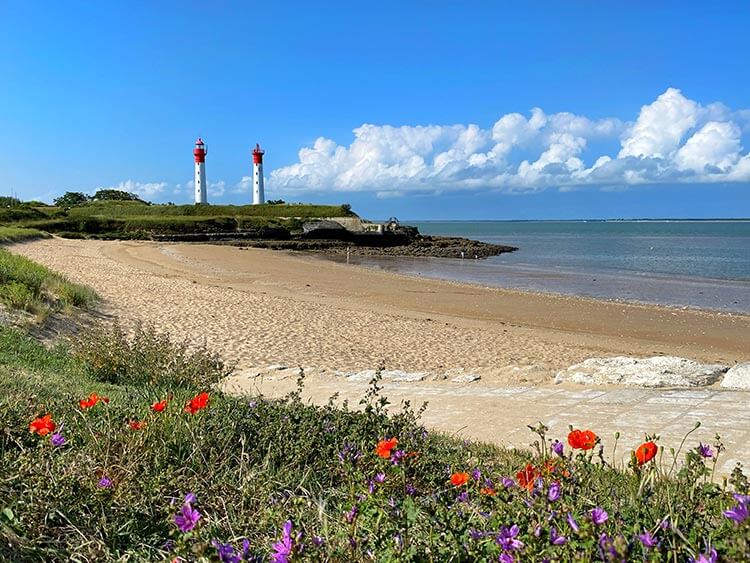
The lighthouse stands protectively over one of the five beautiful beaches of Île d’Aix: Anse de la Croix. The famous Fort Boyard, one of the most visited attractions of the area, stands watch almost directly over the beach from the distance.
First thing in the morning, it’s nearly empty. But both the proximity to the pier and village coupled with the sandy cove being tucked between rocks make it one of the most popular places to swim on Île d’Aix. In July and August, swimming is also monitored on this beach.

At the end of Anse de la Croix, you can cross a small bridge to enter inside the fortifications. Le Sémaphore, the former communications tower, stands prominently at the end of the village. It was key in communications with offshore vessels until 1860. After it fell into disuse, it became extremely dilapidated and was restored just recently from 2018 – 2019. And while you can’t climb the lighthouse, you can climb Le Sémaphore for a 360° panoramic view.
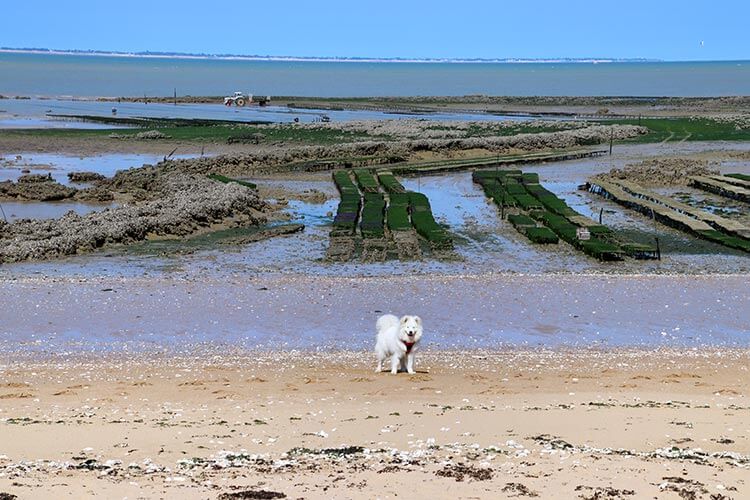
You can continue along to leave the fortifications, coming to the Grande Plage. It’s the largest beach of Île d’Aix, stretching for more than 1 kilometer of the island’s 3 kilometers. A wild beach, you’ll see some of the oyster beds as well as rocky areas uncovered at low tide. The beach is teeming with the shellfish and crabs of the natural marine park, and you’ll spot many people collecting the various mussels, clams scallops and cockles in small buckets. Collecting is allowed (as of this writing), though you should only take what you’ll personally consume.

Heading inland from the Grande Plage, you’ll find a surprising discovery just a few meters from the Plage aux Coquillages. Tucked almost out of notice behind a row of hedges is Île d’Aix’s only vineyard.
Though the monks of Cluny mention wine in the 11th century when there were some 40 hectares of vineyards on Île d’Aix, just one plot a half hectare in size remains today. It’s planted half with chardonnay and half with merlot. The annual production is around 6000 bottles and is sold exclusively on the island in just two shops and at some Île d’Aix’s restaurants.
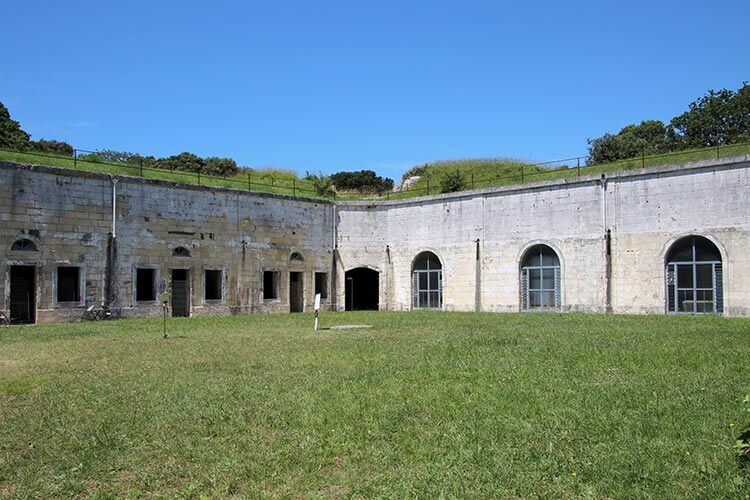
Leaving the vineyard and Plage aux Coquillages, the landscape changes to the forest of Île d’Aix. And tucked into the forest at the north-east end of the island is Fort Liédot. It’s well worth planning some time to tour the fort, which takes about an hour (dogs on leashes welcome).
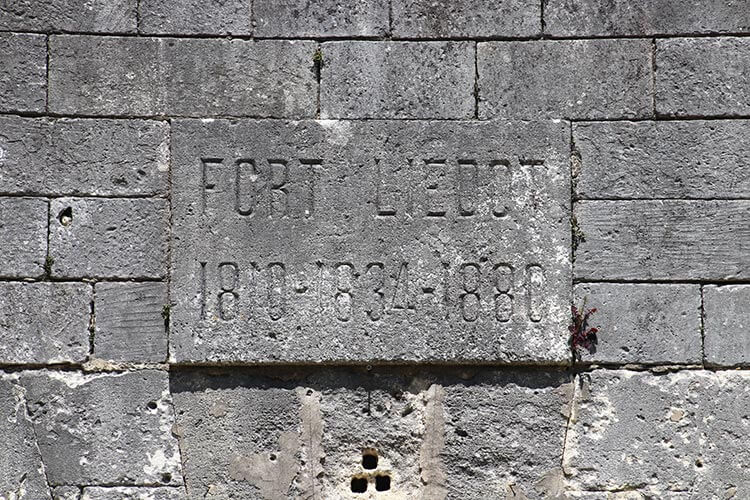
Known as Napoleon’s indestructible fort, the semi-buried fort was indeed never attacked by an enemy. As noted by three important dates chiseled into the stone plaque over the entrance, you’ll discover that Fort Liédot was a bit late to the party. Construction began in 1810, but took 24 years to complete. By the time Fort Liédot was actually completed, it was already rendered useless in the defensive system protecting Rochefort.
Ironically, the damage suffered to Fort Liédot was at the hands of the French when in 1863 the French army fired test shots to test the fortification’s strength. It took two years for the damage from those tests to be repaired.

Though the French heavily bombed Fort Liédot with their test shots, the bastions remained in tact. The guides will proudly tell you bastion number 4 is the most beautiful, and it also has a unique feature. Thanks to the perfect stone masonry, it’s an echo chamber much like the echo chamber in the chapel at Château de Vayres near Bordeaux. Test it out with a mind-blowing game of “telephone” from the corners of the vaulted room.
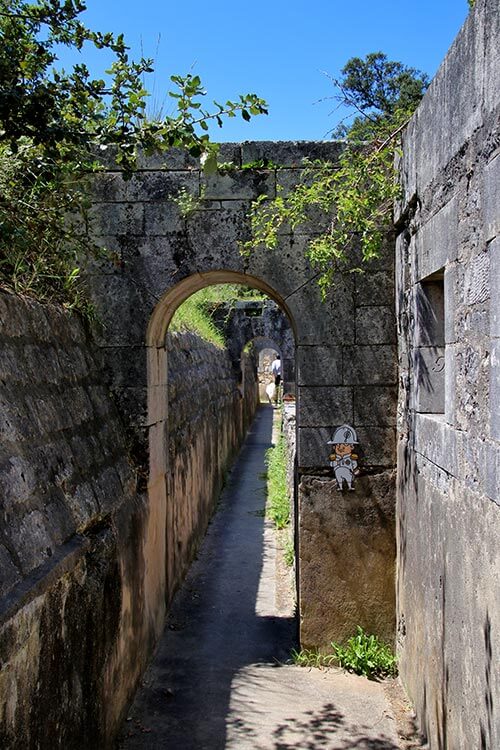
The tour also brings you up on the ramparts of the fort, where many of the fort’s prisoners have left their mark. Etched in the stone are names and dates, some practically works of art.
Of course, after all that trekking around the island sitting down to relax for a bit over a meal is well earned! The fresh shellfish is what to seek out on Île d’Aix. But with just a handful of restaurants on a tiny island that sees up to 5000 daily visitors in the peak months, it’s best to book a table in advance.
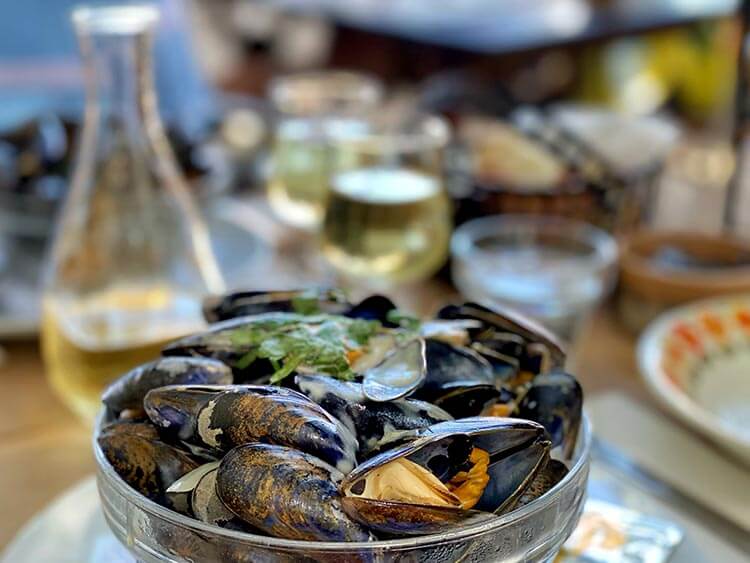
Le Pressior (+33 5 16 84 12 78) located just off the Grande Plage is where you can put your toes in the sand while feasting on a steaming pot of local mussels in a Pineau des Charentes cream sauce. Of course, order with a glass of Pineau des Charentes – it’s truly the local libation on the island.
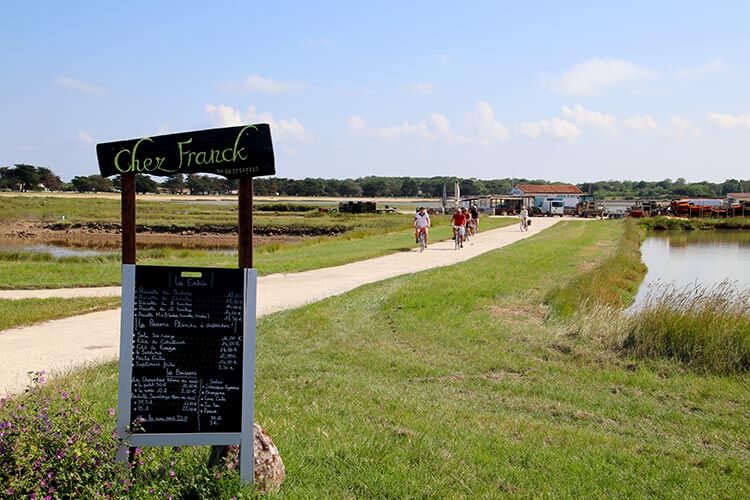
And there’s always room for an oyster tasting. You’ll find Franck Speisser, Île d’Aix’s local oyster farmer, positioned on the way back toward the village. At just €10 for 8 Île d’Aix oysters accompanied by bread, butter and a glass of white wine, you can’t pass up a little local snack.
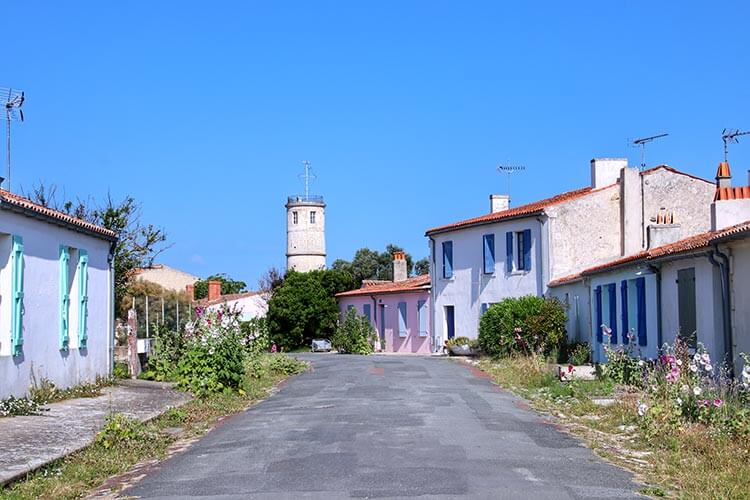
Back in the village, save time to stroll around the lanes with their colorful houses and fragrant blooming hollyhocks. For the perfect souvenir, pop in to Maison de la Nacre. A fixture of Île d’Aix since 1953, the Maison de la Nacre is both a small mother of pearl museum and the workshop of France’s last mother of pearl craftsman. The boutique has a wonderful selection of unique souvenirs from mother of pearl jewelry to little sculptures.
There’s also two museums in the village: The Napolean Museum and the African Museum. The Napoleon Museum is housed in the former commander’s house where Napoleon stayed before his exile, and its 10 rooms are dedicated to Napoleon and his entourage, the history of Île d’Aix and to the important Gourgaud family.
Also belonging to the Gourgaud family before it was bequeathed to the State, the African Museum houses a collection of African animals stuffed by the most famous taxidermist of the time, Rowland Ward of London. The animals were aquired by Baron Napoleon Gourgaud during hunts in Africa over the course of three expeditions from 1913 – 1931.
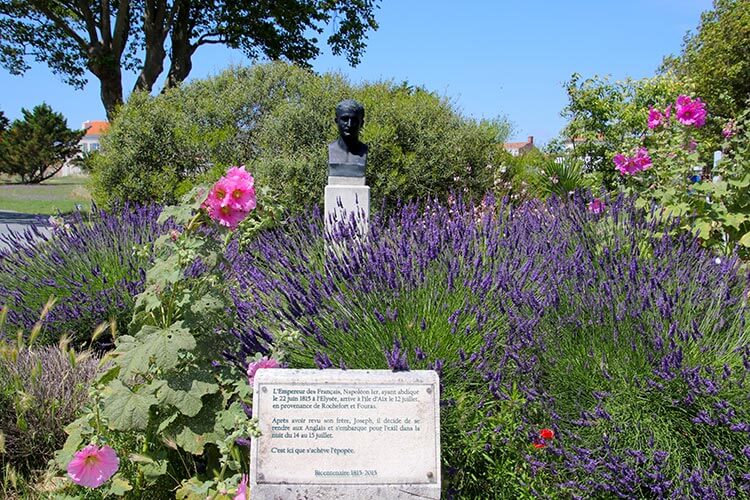
And you can’t leave Île d’Aix without taking a photo of the bust of Napoleon, situated in the village near the port. A small plaque simply declares Napoleon’s chapter with France ended here on the island.
Where to Stay
Île d’Aix has just one hotel, a few campgrounds and some holiday lettings. Most visitors experience Île d’Aix as a day trip, though some do opt to stay for a completely different experience once the day trippers leave.
Hotel Napoleon
Hotel Napoleon is Île d’Aix’s sole hotel. It’s situated in the heart of the village, just a short walk from the pier. The hotel offers 18 rooms and 1 suite, all with a contemporary design. A breakfast buffet is included, wifi is complimentary, and paid parking is available at the port in Fouras. Dogs are not accepted.
Résidence Pierre & Vacances Le Fort de la Rade
Alternately on Île d’Aix, you also have the aparthotel Résidence Pierre & Vacances Le Fort de la Rade. Also located in the village just 300 meters from the pier, the aparthotel offers studio, 1-bedroom and 2-bedroom apartments that are well equipped with kitchens and modern furnishings. There’s an on-site swimming pool, various games and activities are organized both complimentary and at an additional charge. A bakery menu is also available for guests to order breakfast pastries at an additional charge. Dogs are also welcome.
Grand Hôtel des Bains SPA
Located in Fouras, where ferries depart to Île d’Aix, the Grand Hôtel des Bains SPA is just 50 meters from the beach, restaurants and Fort Vauban des Fouras. The rooms are comfortable and the onsite spa is available to all guests. There’s a swimming pool, hamman, sauna and solarium. Massages and beauty treatments are also available in the spa at an additional charge. The hotel does offer parking at an additional charge, and there is also free parking nearby. Dogs are welcome.
Know Before You Go
Our trip to Île d’Aix was in partnership with Rochefort Océan and Destination Nouvelle Aquitaine in order to bring you this story. However, Luxe Adventure Traveler maintains full editorial control of the content published on this site. As always, all thoughts, opinions, and enthusiasm for travel are entirely our own.This article contains affiliate links. When you shop on Amazon or book on Booking.com through our affiliate sites, we earn a small commission at no additional cost to you.
Leave a Reply